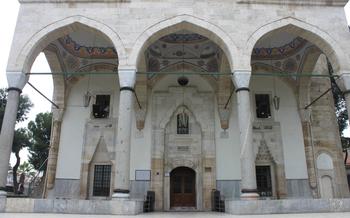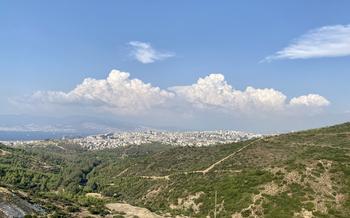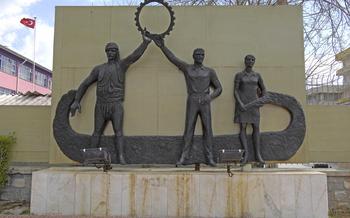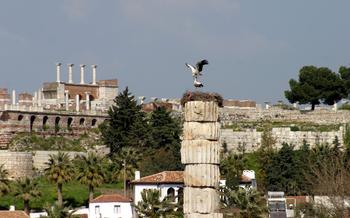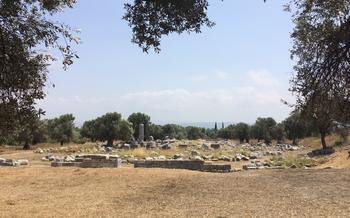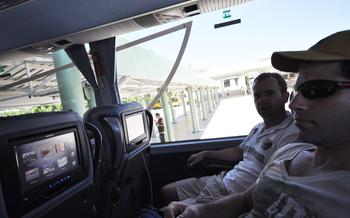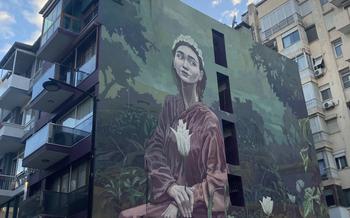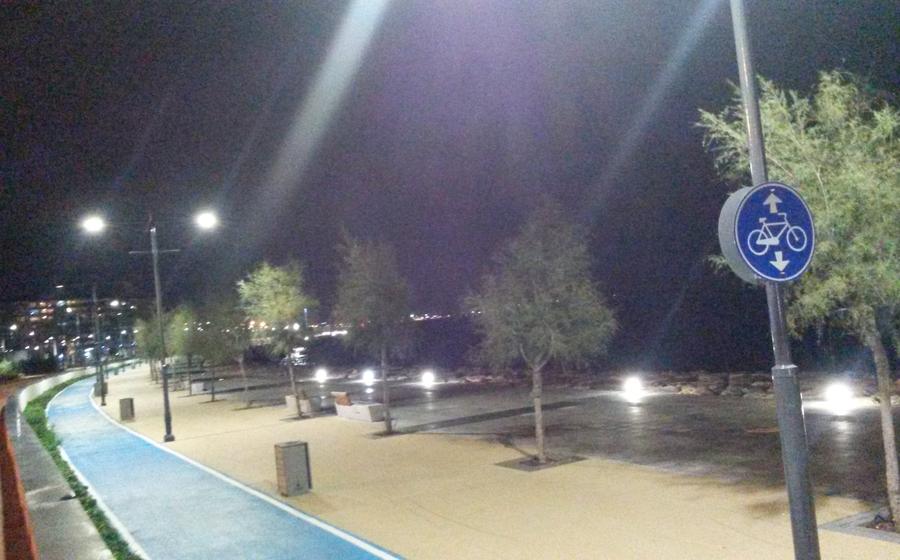
Claros Ancient City
- Historical Background
- Excavations and Discoveries
- Temple of Apollo
- Oracle of Claros: A Renowned Center of Prophecy
- Sacred Way
- Theater
- Agora
- Stoa
- Baths
- Gymnasium
- Necropolis: Exploring the Ancient Burial Ground
- Museum
- Natural Surroundings:
- Visitor Information
- Insider Tip:
Historical Background
Claros, an ancient city nestled on the Aegean coast of Turkey, holds a significant place in history as a religious and cultural center. Its origins can be traced back to the 8th century BC when Ionian Greeks founded the city. Claros soon gained prominence as a major oracle site, attracting pilgrims and visitors from across the ancient world seeking guidance and prophecies from the Oracle of Apollo. The city became a renowned center for the worship of Apollo, the Greek god of prophecy, music, and healing. The oracle's influence extended far beyond the city walls, shaping the lives and decisions of individuals and rulers throughout the Mediterranean region. However, with the rise of Christianity and the decline of the ancient Greek religion, Claros' significance waned, and the city was eventually abandoned, leaving behind a rich legacy and a wealth of archaeological treasures waiting to be discovered.
Excavations and Discoveries
In the 19th century, the ancient city of Claros was largely forgotten and buried under layers of earth and vegetation. However, in the 1880s, a team of archaeologists from the French School at Athens began excavating the site, revealing the hidden treasures of this once-thriving city.
The excavations at Claros uncovered a wealth of significant discoveries, including temples, statues, inscriptions, and other artifacts that shed light on the city's history, culture, and religious practices. Among the most notable discoveries was the well-preserved Temple of Apollo, the city's most prominent structure and the center of religious activity.
Other important discoveries included the remains of the Oracle of Claros, one of the most renowned oracles in the ancient world. The excavations revealed the process of seeking guidance from the oracle, including the rituals and procedures involved, as well as the influence and importance of the oracle's prophecies.
The ongoing excavations at Claros continue to uncover new insights into the city's past. Archaeologists are working to conserve and restore the site for future generations, ensuring that this ancient city and its rich history remain accessible and appreciated by visitors from around the world.
Temple of Apollo
The Temple of Apollo, the most prominent structure in Claros, stands as a testament to the city's religious significance. Constructed in the 6th century BC, this grand temple served as the focal point of religious activity and divination. Its well-preserved facade showcases intricate carvings depicting mythological scenes and deities. The temple's interior, once adorned with statues and offerings, exudes an aura of ancient devotion. Visitors can marvel at the temple's impressive columns, which support a beautifully preserved entablature. The Temple of Apollo remains a symbol of Claros's rich history and cultural heritage, attracting visitors eager to experience the grandeur of this ancient sanctuary. Ongoing restoration efforts aim to preserve and protect this iconic structure for future generations to appreciate.
Oracle of Claros: A Renowned Center of Prophecy
The Oracle of Claros, nestled within the ancient city, was one of the most celebrated oracles in the ancient world, rivaling the fame of Delphi. Its reputation for accurate prophecies attracted individuals and rulers from across the Mediterranean seeking guidance on matters of politics, war, and personal affairs. The oracle's prophecies were highly sought after, and its influence extended beyond the borders of Ionia, reaching as far as Egypt and Persia.
Seeking guidance from the oracle was a solemn and elaborate process. Individuals seeking prophecies would arrive at Claros and undergo purification rituals to prepare themselves for the encounter. They would then offer sacrifices and gifts to Apollo, seeking his favor and guidance. The oracle's prophecies were delivered by a priestess known as the Pythia, who entered a trance-like state and uttered cryptic messages. These messages were then interpreted by the priests of Apollo, who conveyed them to those seeking guidance.
The Oracle of Claros played a crucial role in shaping the political and cultural landscape of the ancient world. Its prophecies influenced the decisions of rulers and had a profound impact on the lives of individuals. The oracle's decline and eventual cessation of operations marked the end of an era, but its legacy continues to inspire and fascinate people to this day.
Sacred Way
The Sacred Way, a processional path paved with marble, served as a grand entrance to the Temple of Apollo. It stretched from the city gates, inviting pilgrims and visitors to embark on a sacred journey towards the temple. Along its path, numerous statues, inscriptions, and other artifacts have been discovered, providing valuable insights into the religious practices and rituals performed in Claros. These discoveries have contributed to our understanding of the city's significance as a center of worship and divination.
The Sacred Way was not merely a path but a symbolic route that symbolized the spiritual connection between the city and the divine. As pilgrims and visitors traversed this path, they were surrounded by sacred symbols and inscriptions, creating an atmosphere of awe and reverence. The Sacred Way served as a physical representation of the spiritual journey undertaken by those seeking guidance and prophecies from the Oracle of Claros.
Today, the Sacred Way stands as a testament to the enduring legacy of Claros. Although time and erosion have taken their toll, the path retains its grandeur and continues to captivate visitors with its historical and spiritual significance. Ongoing efforts to restore and preserve the Sacred Way ensure that future generations can experience the awe-inspiring journey that pilgrims and visitors undertook in ancient times.
Theater
Within the ancient city of Claros lies a remarkably preserved theater, a testament to the city's cultural and artistic significance. This magnificent structure, capable of accommodating thousands of spectators, features an impressive seating arrangement that curves gracefully around the central stage. The well-preserved acoustics of the theater ensure that every word spoken on stage resonates throughout the auditorium, creating an immersive and captivating experience for the audience.
Once the stage for theatrical performances, musical concerts, and other cultural events, the theater played a pivotal role in the social and cultural life of Claros. It served as a platform for storytelling, entertainment, and the exploration of human emotions and experiences. The theater's enduring legacy is evident in the intricate carvings and decorative elements that adorn its facade and stage, showcasing the artistic prowess of the ancient Claros artisans.
Today, the theater stands as a symbol of Claros' rich cultural heritage, inviting visitors to step back in time and immerse themselves in the vibrant atmosphere of ancient Greek theater. Ongoing restoration efforts aim to preserve this architectural marvel for future generations, ensuring that its timeless beauty and historical significance continue to captivate and inspire visitors for years to come.
Agora
The agora, the central marketplace and public gathering place of Claros, was a bustling hub of activity in ancient times. Located in the heart of the city, the agora served as a place for trade, commerce, and social interaction. Merchants from across the region would gather here to sell their wares, from exotic spices and textiles to locally produced pottery and agricultural goods.
Archaeological excavations in the agora have revealed the remains of shops, warehouses, and other public buildings, providing a glimpse into the vibrant commercial life of Claros. The agora was also a place for public assemblies and political discussions, where citizens would gather to debate issues and make decisions on matters affecting the city.
Today, visitors to Claros can explore the ruins of the agora and imagine the bustling atmosphere that once filled this space. The well-preserved foundations of shops and warehouses, along with inscriptions and artifacts discovered during excavations, help to recreate the vibrant scene of ancient market days.
Stoa
Within the bustling agora of Claros, visitors can marvel at the well-preserved stoa, a long, covered colonnade that once served as a sheltered walkway and a vibrant marketplace. Supported by rows of elegant columns, the stoa provided a shaded refuge from the scorching Aegean sun, allowing merchants to display their wares and customers to browse and haggle in comfort.
The stoa's architectural splendor is evident in its intricate frescoes and colorful mosaics, which depict scenes from mythology, nature, and everyday life. These exquisite artworks offer a glimpse into the artistic traditions and cultural influences that shaped Claros during antiquity.
As one strolls along the stoa, one can almost imagine the lively atmosphere of the ancient marketplace, filled with the sounds of merchants hawking their goods, the laughter of shoppers, and the clinking of coins. The stoa served as a vital hub for trade and commerce, where locals and visitors from across the region converged to exchange goods, ideas, and stories.
Today, the stoa stands as a testament to the vibrant commercial and social life that once flourished in Claros. Its well-preserved remains invite visitors to step back in time and experience the bustling atmosphere of an ancient Greek marketplace.
Baths
Within the ancient city of Claros, the well-preserved baths offer a glimpse into the daily lives and customs of its inhabitants. These communal bathing facilities played a significant role in promoting hygiene, relaxation, and social interaction.
The baths were designed with intricate plumbing systems that distributed hot and cold water throughout the complex. They featured separate sections for men and women, each with its own set of pools, changing rooms, and relaxation areas. The pools were heated using an ingenious underfloor heating system, ensuring a comfortable bathing experience even during the cooler months.
The baths were not merely places for cleansing; they were also centers of social interaction and leisure. People gathered here to bathe, socialize, and exchange news and gossip. The baths were often adorned with beautiful frescoes and mosaics, creating a luxurious and inviting atmosphere.
Today, the baths stand as a testament to the advanced engineering and cultural significance of ancient Claros. Visitors can explore the well-preserved pools, changing rooms, and heating systems, gaining insights into the daily routines and social customs of this ancient city.
Gymnasium
Within the ancient city of Claros, visitors can explore the well-preserved gymnasium, a testament to the importance of physical fitness and athleticism in ancient Greek culture. This impressive facility served as a training ground for athletes and a place for citizens to engage in various sports and exercises.
The gymnasium's central feature is its spacious palestra, an open courtyard surrounded by colonnades. Here, athletes would practice wrestling, boxing, and other combat sports. The palestra is flanked by a running track, where sprinters and long-distance runners honed their skills.
Other facilities within the gymnasium include a series of changing rooms, showers, and latrines, catering to the needs of athletes and visitors. The gymnasium's architecture showcases the city's commitment to promoting physical well-being and athletic excellence.
Today, visitors can wander through the gymnasium's ruins, imagining the vibrant atmosphere of ancient sporting events and marveling at the ingenuity of the Greeks in creating such a comprehensive athletic facility. The gymnasium stands as a testament to the enduring legacy of Greek culture and its emphasis on the pursuit of physical and mental excellence.
Necropolis: Exploring the Ancient Burial Ground
Outside the bustling streets of Claros, nestled amidst rolling hills and whispering pines, lies the ancient necropolis, a solemn testament to the lives and legacies of its former inhabitants. Here, in this serene and hallowed ground, the spirits of the departed find eternal rest, their stories etched in stone and whispered by the wind.
Meander through the necropolis, and you'll encounter a diverse array of tombs, each narrating a unique tale. From simple earthen mounds to elaborate stone structures, these resting places reflect the varied social strata and customs of Claros' ancient society.
Peer into the depths of chamber tombs, their walls adorned with intricate carvings and frescoes, telling tales of the deceased's earthly accomplishments and hopes for the afterlife. Discover rock-cut tombs, their facades weathered by time, yet still bearing traces of the artisans' skill and devotion.
Amongst the tombs, you'll find a wealth of grave goods, offering glimpses into the material world of the departed. Pottery vessels, jewelry, coins, and personal belongings accompany the deceased on their final journey, symbolizing their earthly possessions and the continuation of their identity beyond the mortal realm.
Inscriptions carved into tombstones and stelae provide poignant insights into the lives and relationships of those buried here. Epitaphs express love, grief, and hope, immortalizing the memory of the departed and ensuring that their names and deeds live on in the hearts of their loved ones.
The necropolis of Claros stands as a poignant reminder of the cyclical nature of life and death, where the past and present intertwine. As you wander among these ancient tombs, you'll feel a profound connection to the generations that came before you, their stories echoing through the ages, inviting you to reflect on the enduring legacy of human existence.
Museum
The Claros Archaeological Museum is a treasure trove of artifacts unearthed during excavations at the ancient city. It houses a remarkable collection of sculptures, pottery, inscriptions, and other relics that shed light on the rich cultural heritage of Claros. Visitors can embark on a journey through time as they explore the museum's exhibits, gaining insights into the daily lives, religious practices, and artistic traditions of the ancient inhabitants. The museum plays a crucial role in preserving and showcasing the cultural legacy of Claros, ensuring that future generations can appreciate the splendor of this once-thriving metropolis. Educational programs and activities are regularly organized to enhance the visitor experience and foster a deeper understanding of the ancient world.
Natural Surroundings:
The ancient city of Claros is blessed with a breathtaking natural backdrop that enhances its allure. Visitors can immerse themselves in the tranquility of the nearby beaches, where they can bask in the warm sun, build sandcastles, or take a refreshing dip in the crystal-clear waters of the Aegean Sea. The surrounding forests offer a sanctuary for hikers and nature enthusiasts, with trails that wind through lush greenery and provide glimpses of diverse flora and fauna. The majestic mountains that frame the landscape provide stunning views and opportunities for trekking, camping, and mountain climbing.
The region around Claros is home to a rich biodiversity, with many endemic species of plants and animals. Visitors can spot a variety of bird species, including migratory birds that grace the skies during the spring and autumn seasons. The natural environment is a testament to the harmonious coexistence between ancient history and the wonders of nature. Local initiatives and efforts are underway to promote sustainable tourism practices, ensuring that the pristine beauty of Claros is preserved for generations to come.
Visitor Information
Visiting Claros is an enriching experience that offers a glimpse into the ancient world. The site is open to visitors year-round, and the best time to visit is during the spring or fall when the weather is pleasant. Claros is easily accessible by car from Izmir, with clear road signs guiding the way. There is ample parking available near the site.
Once you arrive at Claros, you can purchase tickets at the entrance gate. Guided tours are available in various languages, providing valuable insights into the history and significance of the ancient city. Visitors can explore the site at their own pace, marveling at the well-preserved ruins and imagining the bustling life that once took place here.
Before your visit, remember to wear comfortable shoes as you'll be doing a lot of walking on uneven paths. Don't forget to bring a hat, sunscreen, and water, especially if visiting during the summer months.
After exploring the ancient city, you can relax and enjoy a delicious meal at one of the nearby restaurants in Ahmetbeyli village, which offer traditional Turkish cuisine and stunning views of the surrounding landscape.
If you're planning an extended stay, the town of Ahmetbeyli has several hotels and guesthouses that cater to visitors. These accommodations offer a range of amenities, including comfortable rooms, local cuisine, and assistance with arranging tours and activities.
Keep an eye out for special events and festivals that may be held in Claros throughout the year. These events provide a unique opportunity to immerse yourself in the local culture and traditions.
Insider Tip:
As you wander through the ruins of Claros, take a moment to seek out the enigmatic "Wishing Stone." This ancient stone, nestled amidst the remnants of the city's glorious past, is said to possess the power to grant wishes to those who touch it with sincerity and belief. Embrace the magic of Claros and make a wish as you connect with the spirits of this ancient land. Who knows, the universe may just conspire to make your dreams a reality.
